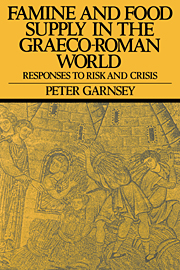Book contents
- Frontmatter
- Contents
- List of tables and figures
- Preface
- Abbreviations
- Maps
- PART I THE INCIDENCE AND SEVERITY OF FOOD CRISIS
- 1 Famine and shortage
- 2 The frequency of food crisis
- 3 The infrequency of famine
- PART II SURVIVAL STRATEGIES
- PART III FOOD SUPPLY AND FOOD CRISIS IN ATHENS C. 600–322 BC
- PART IV FOOD SUPPLY AND FOOD CRISIS IN ROME C. 509 BC – AD 250
- CONCLUSION
- Bibliography
- Index
2 - The frequency of food crisis
Published online by Cambridge University Press: 12 November 2009
- Frontmatter
- Contents
- List of tables and figures
- Preface
- Abbreviations
- Maps
- PART I THE INCIDENCE AND SEVERITY OF FOOD CRISIS
- 1 Famine and shortage
- 2 The frequency of food crisis
- 3 The infrequency of famine
- PART II SURVIVAL STRATEGIES
- PART III FOOD SUPPLY AND FOOD CRISIS IN ATHENS C. 600–322 BC
- PART IV FOOD SUPPLY AND FOOD CRISIS IN ROME C. 509 BC – AD 250
- CONCLUSION
- Bibliography
- Index
Summary
PROXY-DATA
Historians of all periods before the recent past have uniformly lacked both long series of data on harvest-size in the case of staple crops, and direct quantitative data on climate, the main factor affecting agricultural performance. However, ingenious use has been made of food prices and real wages as indices of shortage or abundance, and of wine yields, harvest dates and tree rings as pointers to climatic fluctuations. Ancient historians have been unable to turn to such substitute data, though the work of dendroclimatologists will before long significantly advance our knowledge of the climate of antiquity.
However, the broad pattern of food crisis in antiquity can be recovered if such ancient evidence as exists for food crisis is combined with modern data on climate and agricultural yield. The latter data can be used as substitute or proxy-data in the absence of detailed records of climate for any period of history which experienced substantially similar climatic conditions.
Classical antiquity is generally thought to have been one such time. This supposition receives some general support from the literary sources, which present quite unsystematically a picture of a recognisably ‘Mediterranean’ climate, and from scientific analyses of glacier and tree-line fluctuations and pollen deposits. It is true that scholars have disagreed about the precise pattern of secular climatic change. But if one's interest is in conjuring up the day-to-day, year-to-year conditions of agricultural production largely at a subsistence level, these matters are of less significance than two other points about the ancient climate which are suggested by the modern meteorological data: regional diversity and interannual variability.
- Type
- Chapter
- Information
- Famine and Food Supply in the Graeco-Roman WorldResponses to Risk and Crisis, pp. 8 - 16Publisher: Cambridge University PressPrint publication year: 1988



